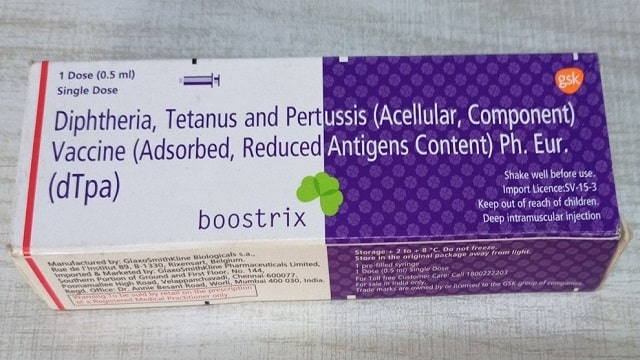What is Boostrix?
Boostrix is a combination vaccine used to provide protection against three serious diseases, namely tetanus, diphtheria, and acellular pertussis.
This vaccine is designed to provide immunity against all three diseases through one injection.
This vaccine, produced by GlaxoSmithKline, is required by the Indonesian Pediatrician Association (IDAI) and the Indonesian Internal Medicine Association (PAPDI).
This means that this vaccine is very important for people who have met the vaccination requirements.
This vaccine is recommended to prevent diphtheria, tetanus, and pertussis.
In addition, vaccination given to pregnant women in the third trimester (27-36 weeks) is carried out to prevent the risk of whooping cough in babies born within 6 months after birth.
Benefits of Boostrix
The Boostrix vaccine is able to protect the body from diphtheria (difficulty breathing), tetanus (muscle spasms), and pertussis (whooping cough) for patients aged 10 years and above, as well as protecting babies from pertussis in pregnant women who receive this vaccination.
Boostrix Vaccine Content
Each dose (0.5 ml) contains:
- Diphtheria toxin
- Tetanus toxin
- Bordetella pertussis antigen
- Pertussis toxin
- Filamentous hemagglutinin
- Pertactin
- Aluminum hydroxide hydrate
- Aluminum phosphate
Boostrix Dosage
The Boostrix vaccine can be given to patients over 10 years of age or pregnant women in their third trimester.
Well, this vaccine can also be given again 10 years after the first dose as a booster.
Here is a more complete dosage:
- Patients aged 10 years and over 1 dose given 5 years after the Td dose or after completing the DTaP vaccine series.
- Pregnant women: 1 dose in the third trimester (27 – 36 weeks).
Each dose of Boostrix vaccine (0.5 ml) contains:
- Diphtheria toxoid 2 IU (2.5 Lf).
- Tetanus toxoid 20 IU (5 Lf).
- Bordetella pertussis antigens:
- Filamentous haemagglutinin 8 mcg.
- Pertussis toxoid 8 mcg.
- Pertactin 2.5 mcg.
- Aluminum phosphate (AlPO4) 0.2 mg.
- Aluminum hydroxide (Al(OH)3) 0.3 mg.
Boostrix Vaccination Schedule
Tetanus, diphtheria, and pertussis vaccines for children, adults, and the elderly.
Boostrix Vaccination Schedule for Children Based on IDAI Recommendations
- The Tdap vaccine is given once starting at age 7 years.
Boostrix Vaccination Schedule for Adults
- The Tdap vaccine is given as 1 dose, and can be repeated every 10 years. For pregnant women, this vaccine is recommended at 27-36 weeks of pregnancy.
Boostrix Vaccination Schedule for the Elderly
- The Tdap vaccine is given as 1 dose, with a repeat dose every 10 years.
How to Use Boostrix
This vaccine is given by injection into the upper arm muscle by a specialist vaccination doctor.
Individuals who will undergo the Boostrix vaccination are not recommended to fast first.
The doctor will clean the upper arm area with cotton wool soaked in alcohol, then inject the vaccine into the upper arm muscle, and finally clean the area once more with alcohol.
Post-Immunization Reactions (KIPI) Boostrix
- In children: fever, irritability, drowsiness, nausea, vomiting, digestive problems, redness, pain, and swelling at the injection site.
- In adults: headache, nausea, pain, swelling, and redness at the injection site.
Caution in Using Boostrix
Patients who have certain health conditions or problems are advised to consult a doctor first before getting the vaccine.
This is done to prevent unwanted effects or impacts.
In addition, this vaccine is also not recommended if the patient:
- Have a history of allergy or hypersensitivity to latex or any component of the Boostrix vaccine or similar vaccines.
- Have had brain or neurological dysfunction, such as Guillain-Barré syndrome, after receiving a previous diphtheria, tetanus, or pertussis vaccination.
- Have a history of seizures, severe acute infections, or unstable epilepsy.
Boostrix Side Effects
Like most vaccines, Boostrix can also cause some side effects.
For mild side effects, among others:
- Pain at the injection site.
- Dizzy.
- Easily tired.
- Diarrhea.
- Fever.
- Stomach ache.
- Nausea and vomiting.
- Mild allergic reactions, such as skin rashes and itchy skin.
Most of these side effects can disappear after a few days, but if they are still felt for a long period of time, contact a doctor immediately for treatment.
In addition, Boostrix can also cause some more serious side effects, such as:
- Severe allergic reactions, such as swelling under the skin, swelling of the tongue, and difficulty breathing.
- Experienced fainting after getting vaccinated.
Although these serious side effects are rare, you still need to be alert.
Therefore, it is important to know the precautions for use, especially regarding allergic reactions to the Boostrix vaccine, to prevent unwanted side effects.
Boostrix Interactions
Boostrix vaccine can be given with other inactivated vaccines, such as meningococcal, pneumococcal, Hib, typhoid, HPV, influenza, hepatitis A, and hepatitis B.
However, it is better to consult a doctor if you are taking the Boostrix vaccine with other vaccines to prevent unwanted effects or impacts.
Boostrix Contraindications
Boostrix vaccine is not recommended for individuals who have a history of hypersensitivity to any of the ingredients contained in this vaccine.
In addition, there are several conditions that make it inadvisable for individuals to receive the Boostrix vaccine.
Some of these conditions are:
- Have a history of significant allergy to a previous Tdap vaccine.
- Have had a coma, decreased consciousness, or seizure within 7 days of receiving a previous DTaP or Tdap vaccine.
- Have a history of thrombocytopenia or neurological problems after receiving a previous DTaP or Tdap vaccine.
It is important to pay attention to and ensure these conditions in order to avoid the risk of unwanted side effects.

